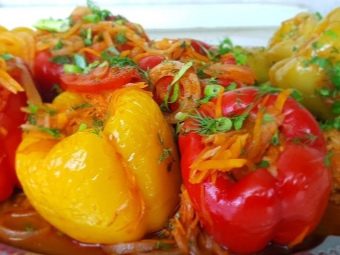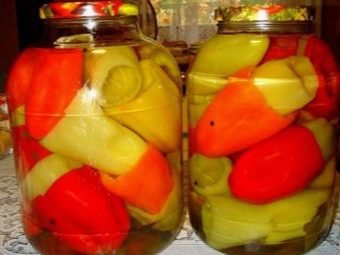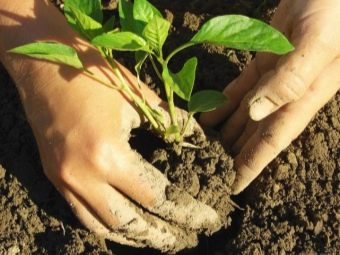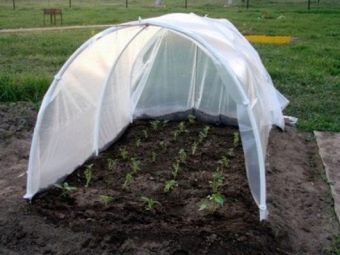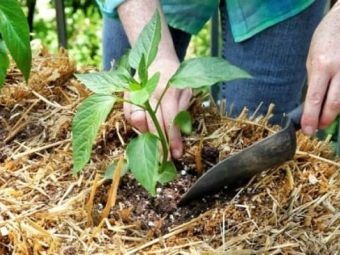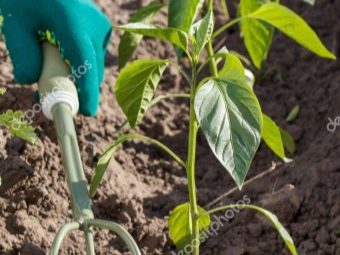Gipsi F1 Pepper: Variety Characteristics and Cultivation Specifications
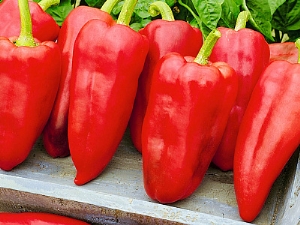
A variety of varieties of pepper makes it difficult to choose gardeners and farmers. Everyone wants to spend a minimum of effort, but to get the maximum yield.Having made a choice in favor of the “Gypsy F1” variety, you will not go wrong, because this pepper has amazing taste qualities that somehow resemble Bulgarian pepper. The presence of a thick wall allows you to use a vegetable for stuffing, and maintaining the perfect shape is useful when pickling.
Variety description
"Gypsy F1" is the earliest, highly productive hybrid variety of sweet pepper, the supplier of which are representatives of the Dutch company Seminis. For a long time, a hybrid was included in the State Register of breeding achievements approved for use on the territory of the Russian Federation. Mainly used for growing on individual plots, garden lands. Fertile pepper development occurs under film cover and in open ground. Experienced gardeners in addition to the central regions are not afraid to grow this variety even in Siberian and Ural lands.
Bushes "Gypsy" in their structure are semi-sprawling, low. Reviews of gardeners report that the plants have thin, almost weak stems, which is why you have to resort to help - a garter for pegs. The number of leaves in ripe pepper does not exceed the norm (there are very few), the leaves themselves are medium, bright green in color. In weight, fruits reach 120 grams, but sometimes exceed the norm by 20 grams or, conversely, weigh slightly less. Sweet pepper variety takes the form of a cone with 2-3 nests.
The flesh of root vegetables can boast an unusual crunch, juiciness, mild sweetness, lack of stinginess and bitterness. Pleasant and the aroma of pepper, which is immediately felt. Fruit peel dense, not rough, stands out for its glossy color. At different stages of maturation, the color changes from greenish-yellow to bright scarlet. The main feature of the vegetable - resistance to cracking of fruits.
Gipsi peppers are in very high demand in the markets, which is easy to explain. In preparing their diverse destination fell in love with the hostess. Peppers are great for stuffing, fresh salads, canned snacks, such as vegetable caviar or lecho. Long transportations and high shelf life of the vegetable are due to the dense skin, which retains all the useful qualities. Agrarians called this variety early-ripening, since the fruits of this hybrid ripen already at 60 days after disembarking on permanent lands, for example, in a vegetable garden or greenhouse.
With proper care, regular dressings and a reasonable approach to the choice of soil, you will get high yields, capable of reaching 4.5 kilograms of fruits of vegetables. Fruiting peppers depends on external influences. To prevent the plant from getting sunburn that will adversely affect the foliar base, it is necessary to close it in hot and sunny weather. Taste component allows you to add to the diet of fresh, canned or frozen pepper.
Without resorting to heat treatment, you will be sure that all the benefits of the product are preserved.
Features of growing
Pepper "Gypsy", which differs in early ripening, you can safely sow on seedlings in any period, the main thing is to determine the place of cultivation in the summer season and the specific time of planting in permanent ground. If there is a good quality greenhouse on the site, which will protect the plant from the April-May frosts, you can safely sow the seeds in the usual period (end of February - beginning of March). Observing all the rules of care, at the beginning of June you will enjoy the first fruits of the hybrid. Creating favorable conditions, the period of development of root crops can drag on for several months.
If the choice fell on cultivation in the open field, then the sowing of seeds should be started somewhere in the middle of April, thereby securing your garden against unexpected spring frosts. According to summer residents, “Gypsy” does not tolerate picks and transplants very well.To protect the roots of the plant from unexpected results, use separate pots for sowing hybrid seeds. Pepper seedlings are very similar to already grown fruits, therefore they cannot boast of special power. And regular fertilizers and top-dressings will make stormy dark greens appear. But do not worry, this is a distinctive feature of the hybrid.
On permanent lands, pepper should be planted in the amount of 6 plants per 1 square meter. In order not to cause unnecessary concern to already flowering plants, immediately tie up the bushes to the stakes. It is necessary and regularly to feed and water plant crops - this is one of your steps to a rich harvest. If possible, plant bushes in shady places, otherwise protect and cover them from direct sunlight.
Properly performed agrotechnical work will save you from constant treatments against plant diseases and pests.
Seedling care
There are no complicated methods for caring for seedlings, but still some rules must be remembered:
- Observe the temperature regime (a plant with newly emerged leaves should be in a room with a daytime temperature of no more than 16 degrees, and a nighttime temperature of at least 2 degrees);
- do not allow the soil to completely dry, slightly soil the soil;
- to feed with mineral additives is seedlings, whose height will reach 10 cm;
- subsequent fertilizing with fertilizers is carried out just before planting the seedlings into open soil (use ash tincture with water as a fertilizer);
- when the transplanting hole is ready, put a little bit of humus on its bottom, it will have a beneficial effect on the germination of roots.
Landing in open ground
Transplanting pepper in open ground is easy enough. Adhering to the basic rules, you can significantly affect the yield of root crops, improve the external and taste state.
- After 2 weeks after you have transplanted pepper to a permanent earthen site, the plant needs mineral fertilization. Immediately carry out a fertilizing procedure is not worth it - you need to give the pepper time to settle down.
- Regular excessive watering will not benefit. The ground should be slightly moist to keep it from drying out and cracking around the seedlings.
- If you are afraid of using chemical types of fertilizer, you can pay attention to the popular method: freshly cut grass + water. The mixture should ferment and brew for about a week. This solution is watered seedlings.
- Do not forget about loosening the land surrounding the plant. Do this carefully to avoid damage to the root system.
- Finding suspicious insects and pests on the leaves of the plant, hurry to recognize the species, after which you can pollinate the bushes with a special preparation.
- During the flowering period, when the fruit begins to form and approaches maturation, we recommend increasing the frequency of irrigation (ripening occurs at the end of July - beginning of August, but Gypsy is able to please the first fruits in the first days of July).
To learn how to properly care and shape the pepper, see the following video.

